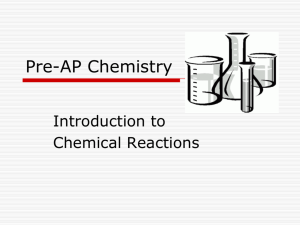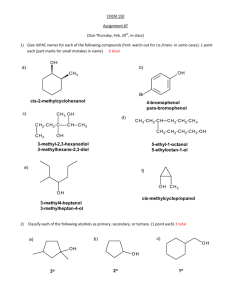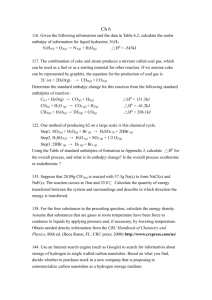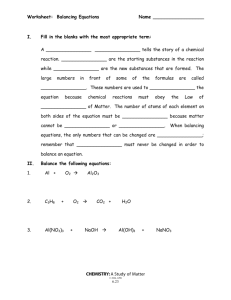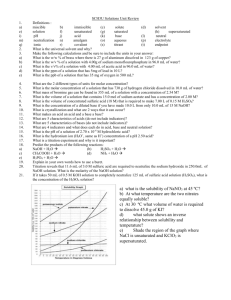Chapter One
advertisement
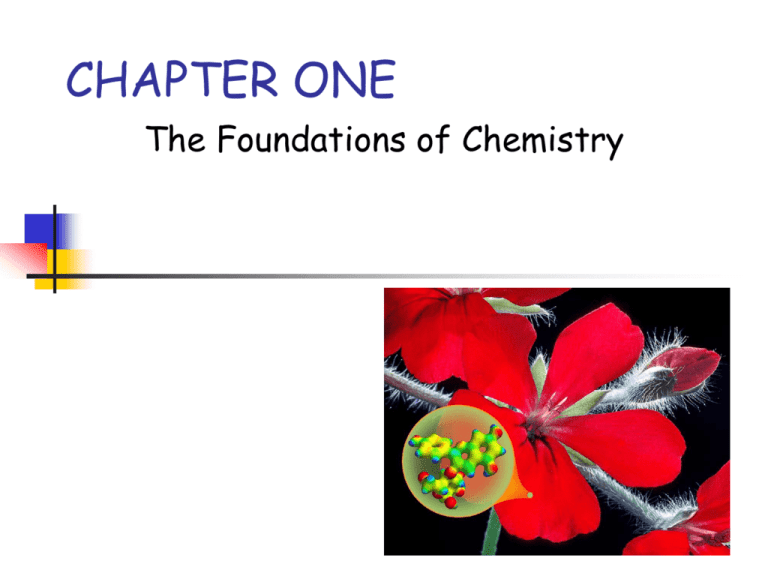
CHAPTER ONE The Foundations of Chemistry Why is Chemistry Important? Materials for our homes Cooking Components for computers and other electronic devices Fuel Body functions 2 Some definitions / Vocabulary Chemistry Matter Anything that has mass and occupies space. (In other words: anything that has mass and volume) Energy Science that describes matter – its properties, the changes it undergoes, and the energy changes that accompany those processes The capacity to do work or transfer heat. Types of energy Kinetic and potential energy Heat energy, light energy, chemical energy, mechanical energy 3 Natural Laws The Law of Conservation of Mass The Law of Conservation of Energy During a chemical or physical change the mass of the system remains constant Energy cannot be created or destroyed in a chemical reaction or in a physical change. It can only be converted from one form to another. The Law of Conservation of Matter and Energy Read at home 4 States of Matter Solid Liquid Gas 5 States of Matter Change States heating cooling Ice Steam Water 6 Substances Substance Examples matter all samples of which have identical composition and properties water sulfuric acid Properties physical properties – physical changes chemical properties – chemical changes 7 Physical Properties Physical properties changes of state density, color, solubility always involve only one substance A substance cannot be broken down or purified by physical means! 8 Mixtures Mixture Homogeneous mixtures a combination of two or more substances can be separated by physical means have uniform properties throughout examples: salt water; air Heterogeneous mixtures do not exhibit uniform properties throughout examples: iron+sulfur; water+sand 9 Chemical Properties Chemical properties chemical reactions always involve changes in composition always involve more than one substance Examples burning of methane rusting of iron oxidation of sugar 10 Decomposition of Water hydrogen Element Element oxygen water Compound 11 Compounds and Elements Compounds If a substance can be decomposed into simpler substances through chemical changes, it is called a compound Elements If a substance cannot be decomposed into simpler substances by chemical means, it is called an element 12 Compounds and Elements Important to remember Law of Definite Proportions both compounds and elements are substances a compound consists of 2 or more elements different samples of any pure compound contain the same elements in the same proportion by mass Symbols of elements found on the periodic chart (learn Table 1-2) www.webelements.com 13 Scientific Notation Use it when dealing with very large or very small numbers: 42,800,000. = 0.00000005117 = 14 Measurements in Chemistry Quantity length mass time current temperature amt. substance Unit meter kilogram second ampere Kelvin mole Symbol m kg s A K mol 15 Metric Prefixes Name mega kilo deci centi milli micro nano pico- Symbol M k d c m n p Multiplier 106 103 10-1 10-2 10-3 10-6 10-9 10-12 16 Metric Prefixes: Examples 1000 m = 0.008 s = 30,000,000 g = 0.07 L = 17 Use of Numbers Exact numbers obtained from counting or by definition 1 dozen = 12 things for example Measured numbers numbers obtained from measurements are not exact every measurement involves an estimate 18 Significant Figures Significant figures digits believed to be correct by the person making the measurement 19 Significant Figures Side B: 13.6 mm >13.5 mm but <13.7 mm in my judgement! 13.6 mm certain figures estimated figure 20 Significant Figures 13.6 mm certain figures + estimated figure significant figures we always report only 1 estimated figure the estimated figure is always the last one of the significant figures 21 Significant Figures - Rules 1) Exact numbers (defined quantities) have an unlimited number of significant figures. We do not apply the rules of significant figures to them. 2) Leading zeroes are never significant: 0.000357 has three significant figures 3) Zeros between nonzero digits are always significant: 20.034 1509 1.0000005 22 Significant Figures - Rules Trailing zeros 4) Zeroes at the end of a number that contains a decimal point are always significant: 35.7000 0.07200 40.0 41.0 5) Zeroes at the end of a number that does not contain a decimal point may or may not be significant (use scientific notation to remove doubt): 173,700 may have 4, 5, or 6 significant figures 23 Significant Figures - Rules Addition/Subtraction Rule 6) The position of the first doubtful digit dictates the last digit retained in the sum or difference. Multiplication/Division Rule 7) In multiplication or division, an answer contains no more significant figures than the least number of significant figures used in the operation. Study examples 1-1 & 1-2 in the book 24 The Unit Factor Method The basic idea of the method: Principles: multiplication by unity (by 1) does not change the value of the expression construct unit factors from any two terms that describe identical quantity the reciprocal of a unit factor is also a unit factor Study examples 1-3 through 1-9 in the book 25 The Unit Factor Method 1 ft = 12 in Unit factors: 1 ft 12 in 12 in 1 ft Example: Express 77.5 inches in feet 1 ft 77.5 in = 77.5 in x = 6.46 ft 12 in See Table 1-7 for various conversion factors 26 More examples 9.32 yrd = ? mm 1. We use the following knowledge to build unit factors: 1 yrd = 3 ft 1 in = 2.54 cm 1 ft = 12 in 1 cm = 10 mm 2. Multiply 9.32 yrd by unit factors to get the value expressed in mm: 3 ft 12 in 2.54 cm 10 mm 9.32 yrd x x x x = 8.52·103 mm 1 yrd 1 ft 1 in 1 cm 27 Density mass density = volume tells us how heavy a unit volume of matter is usually expressed as “g/ml” for liquids and solids and as “g/L” for gases Table 1-8 lists densities of some common substances 28 Density: Example Example: Calculate the density of a substance if 742 grams of it occupies 97.3 cm3. 1 cm3 1 mL 97.3 cm3 97.3 mL 742 g d 7.63 g/mL 97.3 mL Learn examples 1-11 through 1-13 in the book 29 Specific Gravity d (substance) Sp. Gr. = d (water) tells us how much heavier or lighter a substance is compared to water: Sp. Gr. < 1 – lighter than water Sp. Gr. > 1 – heavier than water specific gravity has no units – it is a dimensionless quantity See example 1-14 in the book 30 Specific Gravity: Example Example 1-15: Battery acid is 40% sulfuric acid, H2SO4, and 60% water by mass. Its specific gravity is 1.31. Calculate the mass of pure H2SO4 in 100.0 mL of battery acid. What do we know? 1. The mass percentage of H2SO4 and H2O in the sample of battery acid. 2. Specific gravity of battery acid. 3. Density of water (1.00 g/mL). To find the mass of H2SO4, we need to know the mass of 100.0 mL of battery acid. 31 Specific Gravity: Example m d V m d V d (bat.acid) d (bat.acid) Sp.Gr.(bat.acid) 1.31 d (H2O) 1.00g/mL Therefore, d (bat.acid) 1.31 1.00 g/mL 1.31 g/mL m (bat.acid) 1.31 g/mL 100.0 mL 131 g 40% m (H2SO4 ) 131 g 52.4 g 100% 32 Heat and Temperature Heat and Temperature are not the same thing: Heat is a form of energy T is a measure of the intensity of heat in a body Heat always flows spontaneously from a hotter body to a colder body – never in the reverse direction Body 1 T1 hotter Heat T1 > T 2 Body 2 T2 colder 33 Temperature Scales 3 common temperature scales Fahrenheit 0ºF – freezing (salt+H2O) 30ºF – freezing H2O 90ºF – human body Celcius Kelvin 0ºC – freezing H2O 100ºC – boiling H2O 0 K – absolute zero 273.15 K – freezing H2O http://home.comcast.net/~igpl/Temperature.html 34 Temperature Scales & Water Melting (MP) and boiling (MP) points of water on different temperature scales Fahrenheit Celsius Kelvin MP BP 32 oF 212 oF 0.0 oC 100 cC 273 K 373 K 35 Temperature Conversion degrees Kelvin degrees Celcius ? K = ?ºC + 273 ?ºC = ? K - 273 degrees Fahrenheit degrees Celcius ?ºF = (?ºC)·1.8 + 32 ?ºC = (?ºF – 32)/1.8 Examples 1-16 & 1-17 in the book http://www.lenntech.com/unit-conversioncalculator/temperature.htm 36 Heat Chemical and Physical changes: evolution of heat (exothermic processes) absorption of heat (endothermic processes) Units of measurement: joule (J) – SI units calorie (cal) – conventional units 1 cal = 4.184 J A “large calorie” (1 large cal = 1000 cal = 1 kcal) is used to express the energy content of foods 37 Specific Heat The specific heat (Cp) of a substance: the amount of heat (Q) required to raise the temperature of 1 g of the substance 1ºC (or 1 K) Q Cp m ΔT Units of measurement: J J or g C g K 38 Specific Heat: Example 1 Knowing specific heat, we can determine how much energy we need in order to raise the temperature of a substance by T = T2 – T1: Calculate the amount of heat necessary to raise the temperature of 250 mL of water from 25 to 95ºC given the specific heat of water is 4.18 J·g-1 ·ºC-1. What do we know? the temperature change the specific heat of water the volume of water the density of water 39 Specific Heat: Example 1 heat specific heat m ΔT heat (specific heat) m T T 95C - 25C 70C m d V 1.00 g/mL 250 mL 250 g J heat 4.18 250 g 70C 73150 J 7.3 10 4 J g C Examples 1-18 through 1-20 in the book 40 Specific Heat: Example 2 Given specific heats of two different substances, we can also calculate the heat transfer between them: 0.350 L of water at 74.0ºC is poured into an aluminum pot at room temperature (25.0ºC). The mass of the pot is 200 g. What will be the equilibrium temperature of water after it transfers part of its heat energy to the pot? The specific heats of aluminum and water are 0.900 and 4.18 J·g-1 ·ºC-1, respectively. You might encounter this kind of problem at your first exam 41 Specific Heat: Example 2 What do we know? the pot and water come to equilibrium, that is eventually they have the same temperature the specific heat of aluminum and water the mass of aluminum the volume of water the density of water finally, the Law of conservation of energy which tells us that the amount of heat lost by water is the same as the amount of heat gained by the aluminum pot 42 Specific Heat: Example 2 heat specific heat m ΔT heat (specific heat) m T Let’s denote the final temperature as Tf. Then the changes in temperature for water and aluminum are: T (H2O) 74.0C -Tf and T (Al) Tf 25.0C 1000 mL m (H2O) d V 1.00 g/mL 0.350 L 350 g 1L Note that we used the unit factor method to convert L to mL 43 Specific Heat: Example 2 heat (specific heat) m T heat loss (H2O) heat gain (Al) J J 4.18 350 g (74.0C -Tf ) 0.900 200 g (Tf - 25.0C) g C g C Solving this equation with respect to Tf, we obtain Tf = 68.6ºC Try to solve the equation yourself and analyze why the answer is given with 3 significant figures 44 Reading Assignment Read Chapter 1 Learn Key Terms (pp. 40-41) Go through Chapter 2 notes available on the class web site If you have time, read Chapter 2 45 Homework Assignment Textbook problems (optional, Chp. 1): 11, 13, 15, 18, 27, 29, 30, 32, 36, 41, 43, 47, 49, 57, 62, 68, 80 OWL: Chapter 1 Exercises and Tutors – Optional Introductory math problems and Chapter 1 Homework problems – Required (homework #1; due by 9/13) 46
